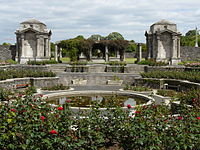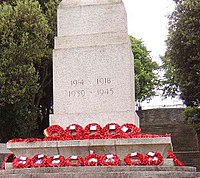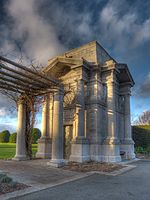Irish National War Memorial Gardens: Difference between revisions
Created page with "right|thumb|350px|Central Sunken Rose Garden and Bookrooms {{county|Dublin}} The '''Irish National War Memorial Gardens''' a memorial gar..." |
mNo edit summary |
||
| (One intermediate revision by one other user not shown) | |||
| Line 1: | Line 1: | ||
[[File:Memorial Rose-Garden 001.JPG|right|thumb|350px|Central Sunken Rose Garden and Bookrooms]] | [[File:Memorial Rose-Garden 001.JPG|right|thumb|350px|Central Sunken Rose Garden and Bookrooms]] | ||
{{county|Dublin}} | {{county|Dublin}} | ||
The '''Irish National War Memorial Gardens''' a memorial garden in [[Islandbridge]], [[County Dublin]], laid out as a war memorial dedicated "to the memory of the 49,400 Irish soldiers who gave their lives in the Great War, 1914–1918",<ref name=ow>Dúchas The Heritage Service, Visitors Guide to the Gardens, from the Office of Public Works</ref> out of over 300,000 Irishmen who served in all armies. | The '''Irish National War Memorial Gardens''' is a memorial garden in [[Islandbridge]], [[County Dublin]], laid out as a war memorial dedicated "to the memory of the 49,400 Irish soldiers who gave their lives in the Great War, 1914–1918",<ref name=ow>Dúchas The Heritage Service, Visitors Guide to the Gardens, from the Office of Public Works</ref> out of over 300,000 Irishmen who served in all armies. | ||
The garden site, chosen in 1931, is about 60 acres in extent stretching parallel along the south bank of the [[River Liffey]] from [[Islandbridge]] towards [[Chapelizod]].<ref name=ow/> | The garden site, chosen in 1931, is about 60 acres in extent stretching parallel along the south bank of the [[River Liffey]] from [[Islandbridge]] towards [[Chapelizod]].<ref name=ow/> | ||
| Line 51: | Line 51: | ||
A wooden cross, the Ginchy Cross, built by the 16th (Irish) Division and originally erected on the Somme to commemorate 4,354 men of the 16th who died in two engagements, is housed in the same building. Three granite replicas of this cross are erected at locations liberated by Irish divisions: Guillemont and Messines-Wytschaete in Belgium, and Thessaloniki in Greece. | A wooden cross, the Ginchy Cross, built by the 16th (Irish) Division and originally erected on the Somme to commemorate 4,354 men of the 16th who died in two engagements, is housed in the same building. Three granite replicas of this cross are erected at locations liberated by Irish divisions: Guillemont and Messines-Wytschaete in Belgium, and Thessaloniki in Greece. | ||
{clear}} | {{clear}} | ||
[[File:War Memorial Gardens Dublin.jpg|left|thumb|800px|Wide view of the War Memorial Gardens]] | [[File:War Memorial Gardens Dublin.jpg|left|thumb|800px|Wide view of the War Memorial Gardens]] | ||
{clear}} | {{clear}} | ||
[[File:Domed Temple, Memorial Gardens, Dublin.jpg|right|thumb|230px|Tholos on the Lime Tree]] | [[File:Domed Temple, Memorial Gardens, Dublin.jpg|right|thumb|230px|Tholos on the Lime Tree]] | ||
Latest revision as of 22:05, 29 April 2021

The Irish National War Memorial Gardens is a memorial garden in Islandbridge, County Dublin, laid out as a war memorial dedicated "to the memory of the 49,400 Irish soldiers who gave their lives in the Great War, 1914–1918",[1] out of over 300,000 Irishmen who served in all armies.
The garden site, chosen in 1931, is about 60 acres in extent stretching parallel along the south bank of the River Liffey from Islandbridge towards Chapelizod.[1]
The Memorial Gardens also commemorate all other Irish men and women who at that time served, fought and died in Irish regiments of the Allied armies, the British, Canadian, Australian, New Zealand, South African and American armies in support of the war effort against Germany and its allies.
Location
- Location map: 53°20’38"N, 6°19’1"W
History

Following a meeting of over 100 representatives from all parts of Ireland on 17 July 1919, a Trust Fund was created to consider plans and designs for a permanent memorial "to commemorate all those Irish men and women killed in the First World War".[1] A General Committee was formed in November 1924 to pursue proposals for a site in Dublin. For technical and administrative reasons it was not until its meeting on 28 March 1927 in the Shelbourne Hotel that Merrion Square, alternatively St Stephen's Green, were proposed. A debate in the Free State Senate failed to resolve the impasse. W. T. Cosgrave, president of the Irish Free State Executive Council then appointed Cecil Lavery to set up a "War Memorial Committee" to advance the memorial process. [2]
Cosgrave who was very interested in bringing the Memorial to fruition met with Sir Andrew Jameson, a Senator and member of the Committee on 9 December 1930 and suggested the present site, at that time known as the "Longmeadows Estates" His proposal was adopted by the Committee on 16 December 1931. Cosgrave said at the time that ". ... this is a big question of Remembrance and Honour to the dead and it must always be a matter of interest to the head of the Government to see that a project so dear to a big section of the citizens should be a success". [2]
General William Hickie saying "the Memorial is an All-Ireland one". A generous gift was sanctioned by the Irish Government in an eleven paragraph agreement with the Committee on 12 December 1933, the Dublin City Council Office of Public Works (OPW) having already commenced work with 164 men during 1932. [2]
In the adverse political conditions of the 1930s Éamon de Valera's government still recognised the motives of the Memorial and made valuable state contributions to it. The cabinet approved work be divided 50% between British and Irish ex-servicemen. [2] Many difficulties arose in 1937 for the WM Committee with regard to plants, trees and the need to obtain a completion certificate from the Office of Public Works, which was finally issued in January 1938. [2] An official opening was agreed for 30 July 1939, but the looming threat of war led to it being postponed. In the end, no official opening ever happened, but the first public event in the gardens took place in 1940 for Armistice Day celebrations.
Design

Designed by the great memorialist Sir Edwin Lutyens who had already landscaped designed several sites in Ireland and around Europe, it is outstanding among the many war memorials he created throughout the world.[1] He found it a glorious site. The sunken Garden of Remembrance surrounds a Stone of Remembrance of Irish granite symbolising an altar, which weighs seven and a half tons. The dimensions of this are identical to First World War memorials found throughout the world, and is aligned with the Great Cross and central avenue.[1] Opposite to the Phoenix Park obelisk, it lies about three kilometres from the centre of Dublin, on grounds which gradually slope upwards towards Kilmainham Hill. Old chronicles describe Kilmainham Hill as the camping place of Brian Boru and his army prior to the last decisive Battle of Clontarf on 23 April 1014. The Memorial was amongst the last to be erected to the memory of those who sacrificed their lives in First World War (Canada's National War Memorial was opened in 1939), and is “the symbol of Remembrance in memory of a Nation's sacrifice”.[3] The elaborate layout includes a central Sunken Rose Garden composed by a committee of eminent horticulturalists, various terraces, pergolas, lawns and avenues lined with impressive parkland trees, and two pairs of Bookrooms in granite, representing the four provinces of Ireland, and containing illuminated volumes recording the names of all the dead.[1]
At the north of the Gardens overlooking the River Liffey stands a domed temple. This also marks the beginning of the avenue leading gently upwards to the steps containing the Stone of Remembrance. On the floor of the Temple are an extract from the "War Sonnett II: Safety" by Rupert Brooke:
"We have found safety with all things undying,
The winds, and morning, tears of men and mirth,
The deep night, and birds singing, and clouds flying,
And sleep, and freedom, and the autumnal earth."
Construction
Workers were so drawn from the unemployed that 50 per cent were former First World War ex-British Army and 50 per cent ex-Irish Army men. To provide as much work as possible the use of mechanical equipment was restricted, and even granite blocks of 7 and 8 tons from Ballyknocken and Donnelly's quarry Barnaculla were manhandled into place with primitive tackles of poles and ropes. On completion and intended opening in 1939 (which was postponed) the Trustees responsible said: "It is with a spirit of confidence that we commit this noble memorial of Irish valour to the care and custody of the Government of Ireland".[4]
Dedication, neglect and renewal

Although commemorations of the fallen by Irish British Armed Forces veterans and families took place at the site for a few years in the late 1940s and 1950s, with some impressive attendances,[5] the politico-cultural situation in the State, and its nationally dominant ideologically adverse view of Ireland's role in First World War, and of those who had volunteered to fight in Second World War, prevented the Garden from being civically opened and dedicated.
The Garden was subject to two Irish Republican paramilitary attacks. On Christmas night 1956 a bomb was placed at the base of its Stone of Remembrance and memorial cross and detonated, but the County Wicklow quarried granite withstood the blast with little damage. Another attempt was made to bring it down again with a bomb detonation in October 1958, which once more failed, resulting in superficial damage.[6]
A subsequent lack of financing from the Government to provision its up-keep and care allowed the site to fall into dilapidation and vandalism over the following decades, to the point that by the late 1970s it had become a site for caravans and animals of the Irish Traveller community, with the Dublin Corporation's refuse disposal office using it as a rubbish dump for the city's waste.[7] In addition fifty years of storms and the elements had left their mark, with structural damage unrepaired to parts of the Garden's ornamentation.
In the mid-1980s economic and cultural shifts began to occur in Ireland which facilitated a regeneration of urban decay in Dublin, and the beginning of a change in the public's view of its national history before Irish independence and of identity, which led to a project of restoration work to renew the park and gardens to their former splendour being undertaken by the Office of Public Works, co-funded by the National War Memorial Committee. On 10 September 1988 the fully restored Gardens were re-opened to the public, and formally dedicated by representatives of the four main Churches of Ireland, half a century after its creation.
Roll of Honour


In the granite paved pergolas surrounding the Garden are illuminated volumes recording the names of the dead, with artwork by Harry Clarke. These were once publicly accessible, although the threat of vandalism has now resulted in these bookrooms remaining closed except for visits by appointment; their contents can be digitally viewed in an onsite office.
A wooden cross, the Ginchy Cross, built by the 16th (Irish) Division and originally erected on the Somme to commemorate 4,354 men of the 16th who died in two engagements, is housed in the same building. Three granite replicas of this cross are erected at locations liberated by Irish divisions: Guillemont and Messines-Wytschaete in Belgium, and Thessaloniki in Greece.


Outside links
- OPW Guide to Irish National War Memorial
- Irish War Memorial Committee archives — held by Royal Dublin Fusiliers Association, online at Digital Repository of Ireland
- The Military Heritage of Ireland Trust
- The Irish War Memorials Project – listing of monuments throughout Ireland
- Dublin Memorials of the Great War 1914–1918
- Regimental Associations:
- Waterford Museum: WWI and Ireland
- Bandon War Memorial Committee
References
- ↑ 1.0 1.1 1.2 1.3 1.4 1.5 Dúchas The Heritage Service, Visitors Guide to the Gardens, from the Office of Public Works
- ↑ 2.0 2.1 2.2 2.3 2.4 'History of the National War Memorial Gardens': History Ireland
- ↑ British Legion Annual, Irish Free State Souvenir Edition 1925–1935; National Library of Ireland, LO .
- ↑ Henry Edward D. Harris (Major) The Irish Regiments in the First World War, pp 210. Mercier Press Cork (1968), National Library of Ireland Dublin
- ↑ 'Come Here To Me, Dublin Life & Culture' 9 September 2013, online magazine article. https://comeheretome.com/2013/09/09/failed-attempts-on-the-war-memorial-gardens-islandbridge/
- ↑ 'Come Here To Me, Dublin Life & Culture' 9 September 2013, online magazine article, 'Failed Attempts on the War Garden, Islandbridge'. https://comeheretome.com/2013/09/09/failed-attempts-on-the-war-memorial-gardens-islandbridge/
- ↑ 'Ireland's Great War', by Kevin Myers (Pub. Lilliput Press, 2014).
- Kevin Myers: Ireland's Great War, Lilliput Press (2014), ISBN 9781843516354
- Thomas P. Dooley: Irishmen or English Soldiers? : the Times of a Southern Catholic Irish Man (1876–1916), Liverpool Press (1995), ISBN 0-85323-600-3
- Myles Dungan: They Shall not Grow Old: Irish Soldiers in the Great War, Four Courts Press (1997), ISBN 1-85182-347-6
- Keith Jeffery: Ireland and the Great War, Press Syndicate of the University of Cambridge (2000), ISBN 0-521-77323-7
- Bryan Cooper (1918): The 10th (Irish) Division in Gallipoli, Irish Academic Press (1993), (2003). ISBN 0-7165-2517-8
- Terence Denman: Ireland's unknown Soldiers: the 16th (Irish) Division in the Great War, Irish Academic Press (1992), (2003) ISBN 0-7165-2495-3
- Desmond & Jean Bowen: Heroic Option: The Irish in the British Army, Pen & Sword Books (2005), ISBN 1-84415-152-2
- Steven Moore: The Irish on the Somme (2005), ISBN 0-9549715-1-5
- Thomas Bartlett & Keith Jeffery: A Military History of Ireland, Cambridge University Press (1996) (2006), ISBN 0-521-62989-6
- David Murphy: Irish Regiments in the World Wars, Osprey Publishing (2007), ISBN 978-1-84603-015-4
- David Murphy: The Irish Brigades, 1685–2006, A gazetteer of Irish Military Service past and present, Four Courts Press (2007)
The Military Heritage of Ireland Trust. ISBN 978-1-84682-080-9 - Stephen Walker: Forgotten Soldiers; The Irishmen shot at dawn Gill & Nacmillan (2007), ISBN 978-0-7171-4182-1